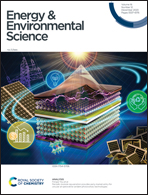Exploring the significance of packing modes and 3D framework sizes and utilizing three chlorine-mediated acceptors and the “like dissolves like” approach for achieving an efficiency over 19%†
Abstract
The exploration of the variations and connections of molecules in the iterative process involves material development for high-performance solar devices, particularly for understanding the molecular packing, intermolecular interactions, and aggregation behaviors of non-fullerene acceptors (NFAs). This study reveals the packing arrangement of three representative chlorine-mediated NFAs, namely ITIC-4Cl (A–D–A), BTIC-EH-4Cl, and BTIC-C9-4Cl (A–D–A–D–A), showing differences in linear to compact 3D network packing structures, thus suggesting the direction of development of NFA materials with gradually enhanced device performances. The reason for the differences in the 3D framework size was also revealed, with the numbers and the modes of electronic junctions being attributed to factors affecting electron mobility. Several tests, including HRTEM, GIWAXS, UV-vis, and variable temperature infrared, were employed to establish the connections between single-crystal structures and nanocrystalline bulk heterojunction domains in film states. Understanding the molecule packing in the blend films by single-crystal analysis was found to be helpful in exploring the electron transport behaviors for better molecular design. Finally, a “like dissolves like” concept in a co-acceptor-based system was proposed. This involves using molecules with similar packing arrangements in single crystals as ternary guests, which could improve the ternary strategy with respect to better material compatibility and improved device performance. This led to a champion power conversion efficiency (PCE) of 19.01% in the ternary devices based on the BTIC-C9-4Cl : L8-BO (0.6 : 0.6, w/w) co-acceptor, which is one of the highest efficiencies reported based on PBDB-TF/BTIC-C9-4Cl systems. This work emphasizes the importance of packing modes and 3D framework sizes of NFAs and provides new insights into the material design and development of organic solar cells, including the “like dissolves like” approach, from the perspective of similar single crystals promoting the compatibility to cause a significant enhancement in ternary devices.



 Please wait while we load your content...
Please wait while we load your content...